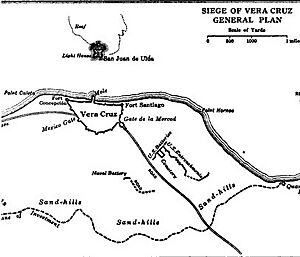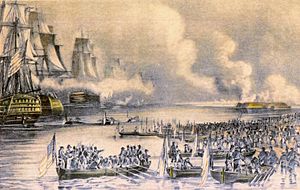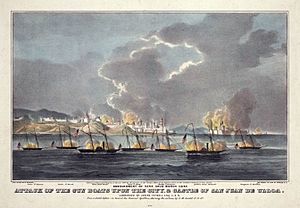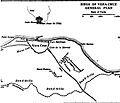Siege of Veracruz facts for kids
Quick facts for kids Siege of Veracruz |
|||||||
|---|---|---|---|---|---|---|---|
| Part of the Mexican–American War | |||||||
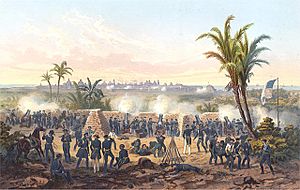 Scott's siege guns were in place on ground outside the city |
|||||||
|
|||||||
| Belligerents | |||||||
| Commanders and leaders | |||||||
| Units involved | |||||||
| See order of battle | See order of battle | ||||||
| Strength | |||||||
| 8,600 | 3,360 | ||||||
| Casualties and losses | |||||||
| 13 killed 55 wounded |
80–350 killed 50 wounded 3,000 captured |
||||||
| 100–1,000 civilians killed | |||||||
The Siege of Veracruz was an important battle during the Mexican–American War. It lasted for 20 days, from March 9 to March 29, 1847. This battle was a siege of the Mexican seaport city of Veracruz. It was also the first time the United States military launched a large-scale attack from the sea onto land, known as an amphibious assault. After the city surrendered, U.S. forces marched inland towards Mexico City.
Contents
Why was Veracruz important?
After earlier battles like Monterrey and Buena Vista, many U.S. soldiers were moved to join General Winfield Scott. Scott and other leaders in Washington decided to attack Veracruz. They planned to land troops there and then move further into Mexico.
Mexican leaders knew the U.S. planned to attack Veracruz. However, problems within their government stopped them from sending more soldiers to defend the city.
Who fought in the battle?
The Mexican forces defending Veracruz had about 3,360 soldiers. They were led by Brigadier General Juan Esteban Morales. The U.S. forces had about 8,600 soldiers. They were led by Major General Winfield Scott and naval officers David Conner and Matthew C. Perry.
How was Veracruz defended?
Veracruz was known as the strongest fortress in North America at that time. It had three main forts protecting it:
- Fort Santiago was at the south end of the city.
- Fort Concepción was at the north end of the city.
- Fort San Juan de Ulúa was offshore on a reef.
These forts had many cannons and soldiers ready for battle.
How did the U.S. land their troops?
The American ships arrived near Veracruz in early March. General Scott agreed to land the troops at Collado Beach, which was about 3 mi (4.8 km) south of Veracruz.
The first group of soldiers to land was General Worth's division. Then came Patterson's volunteers, followed by Twiggs' division. Naval ships, called the Mosquito Fleet, moved close to the beach to provide cover fire if needed.
On March 9, 1847, at 5:30 pm, the landing began. General Worth and his staff were among the first to jump ashore. Amazingly, Worth's entire division landed without any fighting. By 11 pm, Scott's whole army was on land, and not a single soldier was lost. This was a huge success for the first large-scale amphibious landing by the U.S. military.
The siege of the city
Surrounding the city
Once on land, Patterson's division began marching north. Their goal was to completely surround the city of Veracruz. One of Patterson's groups cut off the road to Alvarado and the city's water supply. By March 13, the U.S. army had created a 7 mi (11 km) siege line around Veracruz. This line stretched from Collado in the south to Playa Vergara in the north. On March 17, they started digging trenches for their large cannons. These cannons were strong enough to attack the city, but not Fort Ulúa.
The attack begins
Mexican soldiers from the city often tried to break through the siege lines. On March 20, Commodore Matthew C. Perry returned with more ships. He met with General Scott to discuss how the Navy could help. Perry offered six cannons from his ships, which would be operated by sailors. These naval cannons were set up about 700 yd (640 m) from the city walls. Captain Robert E. Lee helped direct their construction.
On March 22, General Morales refused Scott's demand for surrender. So, the American cannons began firing at 4:15 pm. The Navy's heavy cannonballs easily broke through the city's coral walls. Congreve rockets were also fired into the defenses. The strong attack forced the Mexicans to leave Fort Santiago. Many civilians in the city were killed, and Mexican morale began to drop.
On March 24, U.S. soldiers captured a Mexican soldier who reported that General Antonio López de Santa Anna was marching an army from Mexico City to help Veracruz. General Scott sent Colonel William S. Harney to check on this report. Harney found about 2,000 Mexican soldiers nearby and asked for more troops. General Patterson led a group of volunteers and dragoons to help Harney. They pushed the Mexican forces back towards Medellin.
Veracruz surrenders
General Scott was planning a full assault on the city. But on March 25, the Mexicans asked for a cease-fire to let women and children leave. Scott refused this request. That night, General Morales's war council decided to surrender. Morales then resigned, and General José Juan Landero took command.
A truce was called at 8 am on March 26. The two sides then negotiated the terms of surrender, which were agreed upon by March 27. On March 29, the Mexican forces officially surrendered Veracruz and Fort Ulúa. Later that day, the U.S. flag was raised over San Juan de Ulúa.
What happened next?
With Veracruz captured, the path to Mexico City was open. General Scott immediately planned to leave a small group of soldiers in Veracruz and march inland. His first goal was to reach Jalapa. On their way, Scott's army would meet a large Mexican army led by Santa Anna at the Battle of Cerro Gordo.
Images for kids
See also
 In Spanish: Asedio de Veracruz para niños
In Spanish: Asedio de Veracruz para niños


